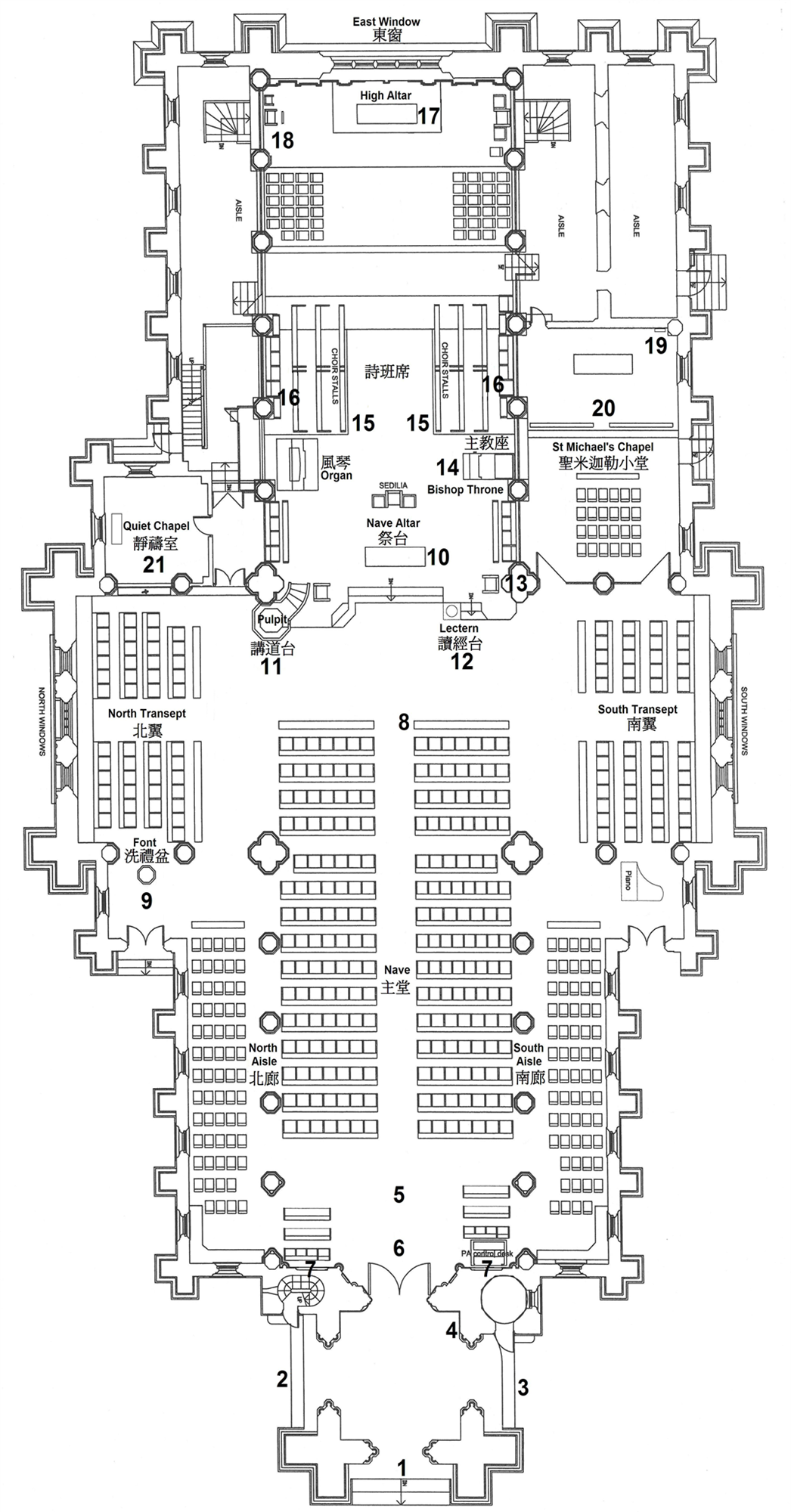St John's opened for divine service on Sunday 11th March 1849.
The final design for the Cathedral was prepared in the Surveyor General’s Office and built with local labour. The architectural style is a plain and unadorned adaptation from 13th Century Early English and Decorated Gothic, the popular revivalist style for churches at the time. The chancel was shorter before the extension in 1873.
During the Japanese occupation of Hong Kong from 1941 to 1945, the Cathedral was converted into a club for the Japanese. Many of the original fittings were stripped out, including the original stained glass which was designed by the English firm of William Morris.
In the Cathedral grounds by the Celtic Cross (to the North West of the church) is the grave of Private Maxwell. He was killed in action in the battle for Hong Kong. He was a Roman Catholic and was buried in the nearest suitable place to where he died.

Tower and West Door
(1) The initials VR on the west face of the Tower commemorate the foundation of the Cathedral in 1847 during Queen Victoria’s reign.
(2) & (3) The coats of arms of two former Governors of Hong Kong, Sir John Davis (1844-1848) and Sir George Bonham (1848-1854)
(4) A plaque commemorating the peal of bells given in honour of Queen Elizabeth II’s coronation in 1953.
(5) The mosaic was added in 1968. The East Syrian Christian Cross at the centre is a 13th Century design discovered in China. The eagle, the symbol of St John, is a local white-bellied sea eagle. The other symbols represent the Holy Trinity: the hands of God the Father creating; the symbols of Jesus death; the dove and fire for the Holy Spirit. The blue background represents the waters of baptism through which we enter the Church.
(6) The wooden font is used for baptism in different parts of the Cathedral. In baptism people join the Christian family.
(7) Succession Lists of Deans and Bishops
Nave and Transepts
(8) The first pew on the South side bares the Royal Arms. Before the Handover in 1997, the pew was reserved for the Governor or any member of the Royal Family visiting Hong Kong.
(9) The font in the north transept is made of stone and dates from 1890. It was originally located in what was the Baptistry, now the Quiet Chapel.
Chancel and Choir
(10) The Nave Altar was placed above the Chancel steps in 1968. It is where the Eucharist is celebrated on Sundays and major festivals.
(11) The pulpit is used during services for preaching about the Christian faith. It is likely that the pulpit was given in 1898 by Sir William Robinson the then Governor. The canopy above is part of the original Bishop’s Throne.
(12) The lectern is made of brass and is where the Bible is read to the congregation. The eagle is carrying on its back God’s Word to the world, symbolized by the sphere at its feet.
(13) Canterbury Cross is a replica of an 8th century cross from Canterbury, England. It was given to the Cathedral in 1935.
(14) The Bishop’s Chair dates from 1957. The name Cathedral comes from the Bishop’s Chair (cathedra in Greek).
(15) The choir stalls. The Anglican choral tradition is central to worship at the Cathedral.
(16) Coats of arms of British Dioceses hang around the Chancel.
(17) The High Altar. Up to the liturgical reforms of the 1960s, this is where the main services of Holy Communion were celebrated. Now, it is used on special occasion.
(18) The chair with the dragon’s head arms is part of the old Bishop’s Throne.
(19) The Aumbry houses the reserved Communion. We meet Christ in bread and wine in the Holy Communion.
(20) St Michael’s Chapel. The chapel was established to commemorate those who died defending Hong Kong against attack in 1941. It was rededicated in 1956 to St Michael and All Angels following The death of Michael Temple, the six-year-old son of the then Dean.
(21) The Quiet Chapel was installed in 1981 in what was the Baptistery. It is now open for silent prayer and meditation.